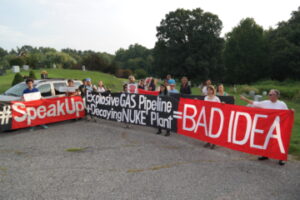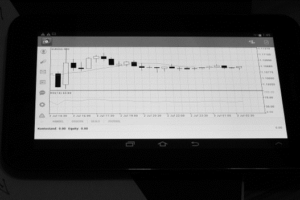
Marilyn Elie, co-founder of the Indian Point Safe Energy Coalition, has tracked events at the now-decommissioned nuclear energy power plant over the past quarter-century. The Cortlandt Manor resident’s seminal role as an anti-Indian Point activist is cited in an April 2022 senior thesis by Yale University anthropology major Eric Krebs, titled, Atoms on the Hudson: Environmentalism, Nuclear Power, and the Long Closure of Indian Point.
In his introduction, Krebs calls the thesis “an anthropological and historical account of the life and death of America’s oldest private nuclear power plant, Indian Point. The first reactor at Indian Point powered on in 1962, and the last reactor at the plant was shuttered on April 30, 2021 after decades of legal and political strife.”
Krebs, who says the thesis is “the first scholarly attempt at chronicling and analyzing the story of Indian Point’s long closure,” sought to document changing and conflicting conceptions of environmentalism in the Hudson Valley, and how political and economic tides shaped the fight for and against the plan. The question he sought to answer was: how was New York’s largest source of zero carbon energy shut down in the name of environmentalism?
Here is an excerpt from the Krebs thesis that pertains to Elie’s role …
Written by Eric Krebs
In December 2001, while the “professionals” focused on the PCBs [Polychlorinated Biphenyls] cleanup, anti-nuclear activism in the Hudson Valley was relegated mostly to a small, relatively tight-knit network of part-time advocates who formed their own networks and strategies.
When she wasn’t protesting Indian Point, Marilyn Elie worked as an elementary school librarian. “Nuclear always bothered me because of the waste,” says Elie. “As a teacher, I saw these little kids come walking through my door, they were all bright-eyed and shiny and everything and I thought: ‘What are we handing over to them?”
Elie was turned on to Indian Point activism in the early 1990s, when she was in her early 50s and in need of something new. Elie began attending meetings at Westchester People’s Action Coalition [WESPAC], a progressive advocacy non-profit. Through WESTPAC, Elie met people like Connie Hogarth — the group’s co-founder who was among the 200 protesters arrested at a 1979 Indian Point Protest — and Barbara Hickernell, another local activist who, at the time, helmed the Alliance to Close to Indian Point.
***
In 1996, Elie — along with fellow activists Margo Shepard and Mark Jacobs, both of whom she had met through WESPAC — formed the Indian Point Project, which would soon thereafter be renamed Westchester Citizens Awareness Network. The name was inspired by the Massachusetts-based Citizens Awareness Network [CAN], the grassroots group that succeeded in closing the Yankee Rowe Nuclear Power Station in 1992.
As they learned the ropes of anti-nuclear activism, Elie and colleagues would travel north to attend workshops held by Deborah Katz, CAN’s Founder and President. “She did a boot camp,” says Elie. “Deb taught me how to read Nuclear Regulatory Commission reports, and how you always look at the footnotes.” Workshops and meetings — in people’s homes, at libraries and local restaurants — were common means by which concerned citizens (“lay people,” as Elie, Katz, and others have described themselves) came to understand the minutiae of nuclear plants and, more importantly, nuclear regulation.
Just as Scenic Hudson, Clearwater, and the Fishermen’s Association had used (and helped create) a growing set of ecological and legal tools to fight Indian Point and Storm King in the 1960s and 1970s, WestCAN sought to pick apart the rules that governed Indian Point and uncover the problems its owners hoped to hide.
***
“We set ourselves up as — I can’t say experts, because we were all lay people — but as accurate sources of information,” says Elie. “The more we learned, the scarier it got.”
Whereas the first generation of anti-Indian Point activism focused on river ecology and the cooling system, WestCAN focused on the perceived threat of radioactive contamination, and using public spectacle to raise the salience of Indian Point as an existential threat. “We tried to do one action per month,” says Elie.
Elie and colleagues once donned hazmat suits and carried anti-Indian Point signs for a tour around the area, and to inform residents of the danger activists believed they were in. One year, around Christmas, the group went to the Buchanan shopping center dressed as the Grinch. “We said, ‘Here’s coal for Indian Point’s Christmas — they don’t get any presents,’” Elie recalls with a chuckle. In January of 2001, the group built snowmen outside Indian Point, holding signs proclaiming that the Hudson Valley had a “snowball’s chance in hell” of surviving an accident at the plant. “I have to say — that was really fun,” says Elie.
***
Later in 2001, Elie and others “convened for dinner at Rafiki’s Natural Foods and Café, a regular haunt for local activists. They were there to meet Timothy Judson, then the director of Citizens Action Network. “We said to Tim, ‘We don’t know what to do here. We’re really stuck,” says Elie. “He looked at all of us and said: ‘We have four people at this table. That’s enough to close a nuclear power plant.’”
Not long thereafter, on a Tuesday morning in September, writes Krebs, history would provide the activists with an unprecedented opportunity to do just that.
Krebs quotes a March 2002 remark by New York State Assemblyman Richard Brodsky that “September 11 [2001] didn’t change the reality about Indian Point, it changed the perception … It increased the danger.” In the wake of the September 11 attacks, notes Krebs, activists would turn from the rhetoric of plant safety to the rhetoric of terror in order to oppose the plant, and previously “neutral” groups like Riverkeeper would be brought back into the fray at Indian Point.
Eric Krebs is a writer and economics researcher. He lives in Queens, New York.







